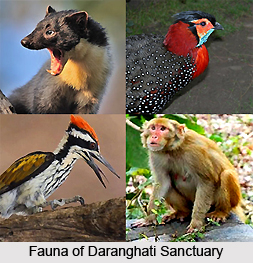 Daranghati Wildlife Sanctuary is a beautiful wildlife reserve which is situated in Shimla in the northern Indian state of Himachal Pradesh and possesses virgin forest grounds. It is present towards the southern or `Nogli Gad` and northern or `Manglad Gad` sides of Dhauladhar Mountains. This sanctuary served as a favourable game reserve of the ruler of Bushahr and it was developed in the year 1962. Numerous wooden temples surround this wildlife sanctuary and tourists visiting this place can receive proper guidance and advice associated to the sanctuary from the regional forest staffs present at Sarahan and Dofda. The total area occupied by Daranghati Wildlife Sanctuary measures nearly about 167 square kilometres and it is based at an elevation of about 2, 100 to 3, 315 metres above sea level.
Daranghati Wildlife Sanctuary is a beautiful wildlife reserve which is situated in Shimla in the northern Indian state of Himachal Pradesh and possesses virgin forest grounds. It is present towards the southern or `Nogli Gad` and northern or `Manglad Gad` sides of Dhauladhar Mountains. This sanctuary served as a favourable game reserve of the ruler of Bushahr and it was developed in the year 1962. Numerous wooden temples surround this wildlife sanctuary and tourists visiting this place can receive proper guidance and advice associated to the sanctuary from the regional forest staffs present at Sarahan and Dofda. The total area occupied by Daranghati Wildlife Sanctuary measures nearly about 167 square kilometres and it is based at an elevation of about 2, 100 to 3, 315 metres above sea level.
Flora of Daranghati Wildlife Sanctuary
One would come across a lush green forest cover inside Daranghati Wildlife Sanctuary which consists of Sub Tropical Broadleaf Forests, Sub-Alpine Forests, Alpine Moist Scrub Forests and Alpine Moist pastures. Cedar trees can be observed at a height of 1, 900 metres to 3, 000 metres above mean sea level while Silver Fir, Spruce and Blue Pine can be found growing in the Coniferous Forests thriving at an elevation of over 2, 000 metres. Almond, Pear, Himalayan Yew, Oak, Apricot, Cherry and Plum are some of the many trees which are existent here.
Fauna of Daranghati Wildlife Sanctuary
Daranghati Wildlife Sanctuary boasts of innumerable wild creatures involving Goral, Leopard, Himalayan Tahr, Musk Deer, Himalayan Blue Sheep, Barking Deer, Ibex, Serow, Yellow Throated Marten, Himalayan Palm Civet, Brown Bear, Himalayan Weasel, Asiatic Black Bear, Red Fox, Striped Hyena and so on. However, one of the most interesting tourist attractions of Daranghati Wildlife Sanctuary is Western Tragopan which is referred to as `Jujurana` or `King of Birds`. Visitors to this sanctuary will be filled with awe noticing several other species of birds like Kaleej, Himalayan Monal, Kokla and other types of Pheasant birds.
Travellers must make it a point to wander around the sanctuary after approaching the closest forest `chowki` which is located in Kashapaat village. The best time to pay visit to Daranghati Wildlife Sanctuary is the time between the months of May, June, October and November. Adventurous tourists can be assured of thrilling moments if they visit this place in the period between December and February. Heavy snowfall is experienced by this region during this season.



















